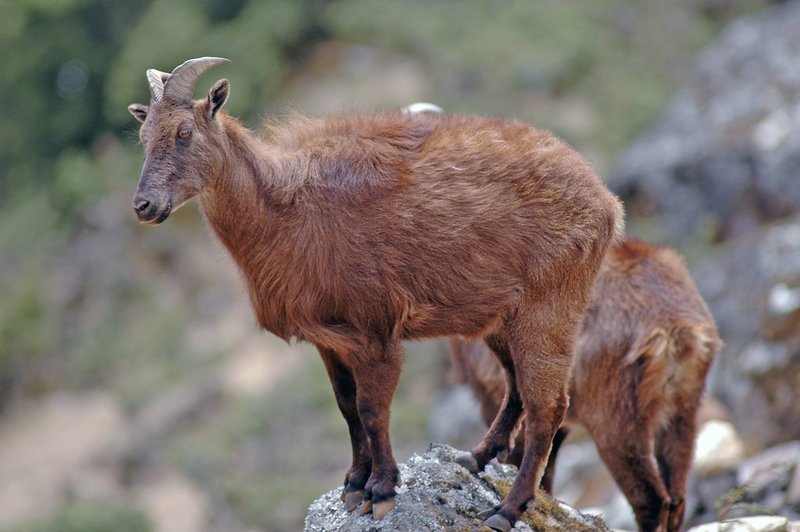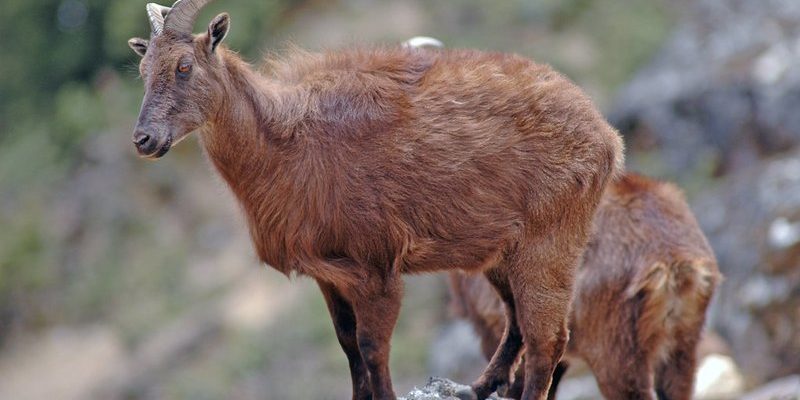
The Himalayan Tahr is a fascinating creature that roams the rugged terrains of the Himalayas. Imagine a goat with a powerful build, sure-footedness, and a thick, shaggy coat; that’s the tahr for you! These animals have adapted brilliantly to their harsh mountain environment, making them a unique marvel of nature. With their striking appearance and intriguing behaviors, they capture the curiosity of wildlife enthusiasts and researchers alike.
Unlike the goats you might see in your local countryside, Himalayan tahrs are perfectly suited for steep, rocky cliffs and high-altitude areas. Their strong legs and specially designed hooves allow them to navigate these treacherous terrains with ease. You might picture them perched on the edge of a cliff, munching on grass and shrubs, seemingly oblivious to the sheer drop below. This adaptability speaks volumes about their survival skills in a climate that is anything but forgiving.
As we dive deeper into the world of the Himalayan Tahr, you’ll discover not just their physical traits but also their social behavior, diet, and the challenges they face in their natural habitat. Come along on this journey through one of nature’s most resilient animals!
Appearance and Physical Characteristics
The Himalayan Tahr is quite a sight to behold. Adult males can weigh between 90 to 125 kg (around 200 to 275 lbs), while females are usually a bit lighter, weighing around 50 to 70 kg (approximately 110 to 155 lbs). Their thick, woolly fur helps keep them warm in harsh mountain climates, and it changes color with the seasons. In summer, their coat tends to be a reddish-brown, while in winter, it shifts to a darker hue, almost greyish. This camouflage is perfect for blending into the rocky environment.
One of the striking features of the Himalayan Tahr is its curved horns. Males sport impressive horns that can grow up to 80 cm (about 31 inches) in length, adding to their majestic appearance. These horns are not just for show; they play a critical role in fights for dominance during mating season. The females, while smaller, also have horns, though they are less pronounced.
When you see a tahr in its natural habitat, you’ll notice their muscular frame and agile movements. Their limbs are strong and well-adapted for climbing steep rocks, and their short, sturdy hooves provide excellent grip. It’s as if they were born to conquer the mountains, and this is precisely how they thrive in such a challenging environment.
Habitat and Distribution
Himalayan tahrs primarily inhabit the steep, rugged slopes of the Himalayas. You’ll find them in regions like India, Nepal, and Bhutan, often in elevations ranging from 3,000 to 5,000 meters (around 10,000 to 16,400 feet). These heights may seem daunting, but for the tahr, it’s home sweet home. They prefer rocky terrains that provide both ample food resources and protection from predators.
They tend to live in groups called “herds,” which can consist of several females and their young, while males often roam solo or with other males. This social structure helps them stay safe, as there’s strength in numbers. The herding behavior allows them to alert each other to potential dangers, such as predators like snow leopards, which are one of their primary threats.
Interestingly, the Himalayan Tahr has a seasonal migration pattern. During warmer months, they move to higher altitudes to take advantage of the lush vegetation, and as the winter approaches, they descend to lower elevations for food. This adaptability to varying altitudes showcases their resilience and flexibility in finding sustenance regardless of the season.
Diet and Feeding Habits
The Himalayan Tahr is primarily herbivorous, munching on a variety of plants, grasses, and shrubs that grow in their mountainous habitat. They are particularly fond of alpine vegetation and can often be seen grazing on the nutrient-rich grasses found in high-altitude meadows. With their strong teeth, they efficiently graze despite the tough textures of their preferred foods.
In terms of feeding behavior, tahrs are browsers, meaning they have the ability to reach higher plants, as well as graze on the ground. They are skilled at finding food in the most challenging conditions—nibbling on leaves and shoots, even in snow-covered areas. Interestingly, they have a habit of standing on their hind legs while reaching for higher foliage, showcasing their incredible balance and strength.
Water is essential for their survival, and while they typically get moisture from the plants they consume, they will seek out streams or pools when necessary. Their foraging habits are crucial not just for their survival but also play a role in maintaining the ecological balance in their habitat by helping vegetation thrive.
Behavior and Social Structure
The social life of the Himalayan Tahr is quite captivating. They usually form herds led by a dominant female, often referred to as the matriarch. This social structure promotes a nurturing environment where females and their young work together to protect one another from danger. Male tahrs tend to be more solitary and only join groups during mating season.
During the mating season, which typically occurs in late fall, males will display their strength and prowess through impressive displays of horn clashing. They engage in physical contests, and the winner earns the right to mate with the females in the herd. This competition can be quite intense, as the stakes are high, leading to some exhilarating encounters.
Beyond the mating rituals, tahrs communicate with each other using a variety of vocalizations, from low grunts to high-pitched whistles. These sounds help maintain group cohesion and alert others to imminent dangers. The intricacies of their social behavior highlight the importance of teamwork and communication in the survival of their species.
Conservation Status
Currently, the Himalayan Tahr is classified as a species of “Least Concern” according to the IUCN Red List. However, that doesn’t mean they don’t face challenges. Habitat loss due to human encroachment, climate change, and poaching are significant threats to their populations. As tourism and agriculture expand into their habitats, the pressures on these majestic creatures increase.
Ecosystem changes, such as shifts in vegetation due to climate change, also pose a risk. As they rely heavily on specific types of plant life for food, any alteration in their environment can affect their ability to thrive. Local conservation efforts are crucial in ensuring that these animals remain protected and that their habitats are preserved.
Community involvement is key to the success of conservation initiatives. By engaging local populations and raising awareness about the importance of the Himalayan Tahr to the ecosystem, we can work towards a future where these incredible animals continue to roam their majestic mountains. Conservation is not just about protecting a species; it’s about preserving the entire ecosystem they inhabit.
Interesting Facts
| Average Weight | 90-125 kg (200-275 lbs) for males |
| Average Lifespan | 10-15 years in the wild |
| Reproduction | Typically mate in late fall; gestation lasts about 6 months |
| Diet | Herbivorous; eats grasses, shrubs, and alpine vegetation |
| Distribution | Found in the Himalayas, particularly in India, Nepal, and Bhutan |
The Himalayan Tahr is a remarkable example of resilience and adaptation in a harsh environment. With their unique physical features, social structures, and diet, they showcase the intricate balance of nature in the Himalayas. Understanding the challenges they face and the importance of conservation efforts can help ensure that these magnificent animals continue to thrive for generations to come.
FAQ
What is the lifespan of a Himalayan Tahr?
The lifespan of a Himalayan Tahr in the wild typically ranges from 10 to 15 years. However, various factors such as environmental conditions and predation can influence their longevity. In more stable and protected habitats, they can reach the upper limit of their lifespan.
Are Himalayan Tahrs aggressive?
While Himalayan Tahrs are not inherently aggressive, males can display aggression, especially during mating season when they compete for females. They may engage in physical confrontations with other males, but generally, they are more focused on foraging and maintaining their social structures.
Do Himalayan Tahrs have any natural predators?
Yes, the Himalayan Tahr faces natural predators in its environment. The most notable predator is the snow leopard, which can navigate the rocky terrain just as adeptly as the tahr. Other threats may include wolves and large birds of prey. The tahr’s social behavior of living in groups helps them stay alert to potential dangers.
What is their primary diet?
The Himalayan Tahr is primarily herbivorous and has a diet that consists of grasses, shrubs, and various alpine plants. They are adept at foraging and can obtain nutrients from tough plant materials, ensuring their survival in rugged mountain terrains.
How do Himalayan Tahrs adapt to their environment?
Himalayan Tahrs have several adaptations for survival, including their thick, shaggy fur that keeps them warm in cold climates and their strong, muscular legs that enable them to maneuver steep, rocky slops with ease. Their social behavior also helps them avoid predators and find food more effectively.
What role do Himalayan Tahrs play in their ecosystem?
The Himalayan Tahr plays a crucial role in its ecosystem by contributing to the balance of vegetation in its habitat. By grazing on various plant species, they help maintain healthy plant growth and biodiversity, which is essential for the overall health of their mountainous environment.
Can I see Himalayan Tahrs in the wild?
Yes! In certain regions of the Himalayas, particularly in national parks and protected areas in India, Nepal, and Bhutan, you can spot Himalayan Tahrs in their natural habitat. Wildlife enthusiasts often go trekking in these areas to observe these remarkable animals up close.
Are Himalayan Tahrs social animals?
Yes, Himalayan Tahrs are social creatures that live in herds, primarily consisting of females and their young. Males usually roam alone or form small bachelor groups. Their social structure fosters cooperation and alertness to dangers in their environment.
How do conservation efforts impact the Himalayan Tahr?
Conservation efforts, including habitat protection and awareness programs, are vital for the survival of the Himalayan Tahr. By safeguarding their natural habitats and engaging local communities in conservation efforts, we can help ensure the continued existence of these magnificent animals.
What is the current conservation status of the Himalayan Tahr?
As of now, the Himalayan Tahr is classified as a species of Least Concern by the IUCN Red List, but they still face threats from habitat loss and climate change. Ongoing conservation efforts are crucial in ensuring their populations remain stable in the wild.

